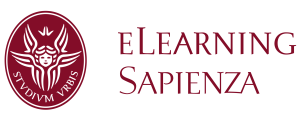الخطوط العريضة للقسم
-
Dear Students,
Welcome to the online English for Medical Purposes course. It is short, hopefully enjoyable, and will not overload you with work this semester. Its primary aim is to show how knowledge of English will become a key resource for you to keep up to date and to help you answer clinical questions and make clinical decisions in future.
We will introduce the idea of Evidence-Based Medicine (EBM) and give you opportunities to learn how to use important medical databases to search for and find answers to clinical problems that concern your patients. Don't forget to read the documents in the Forum section to get a fuller description of what EBM means.
There are 4 lessons. Each lesson begins with a case scenario or problem which you will analyze in different ways. For example, each lesson asks you to read about a patient problem, listen to related videos, search online for answers or read medical documents. Some exercises also ask you to answer online quiz. There are also video tutorials to improve your search skills on MEDLINE. These basic skills are important objectives of this course and for the final exam too. Practice them here.
Finally, I encourage you to contribute to forums with your colleagues which you can do in English and Italian. After all, you will be working in a bilingual environment in medicine - the evidence from clinical research is in English - but your workplace is Italian! One of the aims of EBM is to share and communicate research to keep practitioners up to date. In this way it can also be a potential lever for changes to improve healthcare. What about in our hospital? The first lesson on hospital infection risks gets you started!
What else? The exercises you do here and the skills you develop in this module mirror what you need to do in the final exam in Year 5.
I hope you find it enjoyable and useful.
Buon Lavoro!
Huon Snelgrove
-
Instructions
Read the Case scenario on Hospital hand hygiene which introduces this lesson. After, watch the video as many times as you wish and answer the online questions. Participate in the forum with your colleagues and read the documents which are shown below and in the links in resources. These documents provide research evidence for you to complete the final written exercise: an online petition.
You can write in English and in Italian. We work in a bilingual system, but you need to read the evidence in English!
Case Scenario
You are a medical student at Umberto I. You have noticed that soap in public areas of the hospital and in toilets for students and visitors is often absent. Some students carry their own gels, but not all. Visitors to the hospital have similar problems. They can't wash their hands properly before and after visiting their loved ones You have not, for example, seen many alcohol-based gel dispensers in the patient areas for use by students or relatives and friends visiting patients. Is this a safety risk for patients? You seem to remember seeing that hand hygiene dispensers were available to the public at some other hospitals in your city – e.g. Frati Beni Fratelli – and are concerned that a large teaching nosocomio like Umberto I is not providing these to hundreds of visitors and students studying and working in the hospital every day. You ask yourself if this has a negative effect on patients in the hospital.
Look at the video from the Centre for Disease Control (CDC, USA) and answer the questions. After, share your own experiences and impressions on the Forum 'Mani pulite al Policlinico'
-
Watch a medic at the prestigious international centre for disease control explain the need for hand hygiene in our hospitals.
-
Instructions
Watch the video as many times as you like then answer the questions.
-
Instructions
This is an open bilingual forum for students to share your experiences. You can post in English or Italian. You don't have to participate if you don't want to. The questions are to get started:
How easy is it to wash your hands at Umberto I?
How easy is it for the public? What about doctors, nurses and health care providers?
Should the faculty of medicine be concerned?
The data in the table below compares hand cleansing alcohol rubs in Europe. Does the data in Italy surprise you? (You can find the complete report in Resources below)
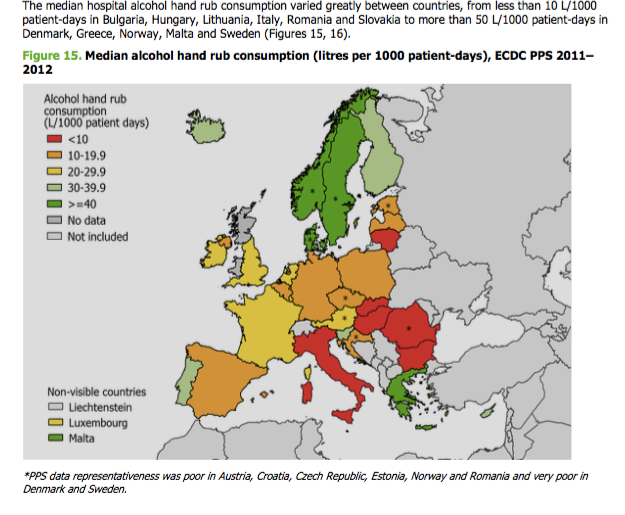
-
Instructions
Read the document on 'Hand Hygiene compliance' to learn how one group of researchers studied hand hygiene among visitors to their hospital. When you finish, click on the 'Reading' link here and answer the questions in the quiz below the text.
Letters to the editor
Hand hygiene compliance by visitors to
Hospitals: can we do better?
To the Editor:
We read with interest the recent article by Birnbach et al,1 which observed hand hygiene compliance (HHC) by visitors to a private university hospital and the effect of visual cues on HHC. The authors report a rate of HHC at the main hospital entrance by visitors of just 0.52% at baseline, which increased to a HHC rate of 11.67% with the aid of visual cues and a large freestanding alcohol- based hand sanitizers (AHS) dispenser. We report similar and additional interventions undertaken to encourage and improve HHC by visitors attending our hospital.
Connolly Hospital Blanchardstown (CHB) is a 300-bed general hospital in Dublin, Ireland. In Ireland, as in other countries, reduction in health care-associated infections and improvement in HHC by health care workers is recognized as a key priority to improve delivery of safe patient care. Indeed, since 2011, Irish health authorities have requested acute hospitals to report 6 monthly rates of HHC by health care workers by using a hand hygiene observational audit tool based on the World Health Organization 5 moments of hand hygiene. The Irish health authorities have set targets of HHC by health care workers of 75% in 2011 and >90% by 2013. However, the compliance of hospital visitors with hand hygiene is largely unmonitored, unreported, and varies widely in the published literature (0.52%-57%).1-3 HHC compliance by visitors is important to prevent transmission of potentially harmful pathogens, acquired in the community, to already vulnerable hospitalized patients. To measure HHC by visitors attending our hospital, we performed a directly observed study of visitor HHC, over a total of 9 hours, on 5 nonconsecutive days during September 2011. Observation of HHC compliance by visitors was performed between 14:00 and 20:00 hours during the study period. All visitors were monitored for use of AHS while passing an AHS dispensing unit located at 3 distinct locations within the hospital: the main foyer, entrance to 4 different acute wards, and within the wards at the point of access to the single rooms. The level of promotion of hand hygiene however varied in a stepwise manner from a large freestanding hand hygiene promotion unit with AHS dispensers in the main hospital foyer bearing the slogan “clean hands save lives” and “talking posters,” which reminded staff/visitors to wash their hands, to laminated reminder messages on the floor directing the visitor to a single AHS dispensing unit placed on the wall at ward entrances and finally a single AHS dispensing unit but no hand hygiene prompts at the entrance to single patient rooms. As well as the large hand hygiene promotion unit at the main entrance, the glass entrance doors to the hospital and main foyer also contained large stickers advising visitors to practice hand hygiene.
A total of 823 hand hygiene opportunities by hospital visitors was observed during the study period. Visitor HHC was shown to vary by location, with 44% (262/592) of visitors performing hand hygiene at the hospital entrance, 4.1% (8/194) at the ward entrance, and 2.7% (1/37) at entrance to single rooms. A mean compliance of 34.2% for a total of 823 hand hygiene opportunities was recorded with an increased level of HHC at main hospital entrance versus other locations. This is in keeping with the improved level of compliance when using visual and physical cues as described by Birnbach et al,1 but the significantly increased level of compliance in our study (44% vs 11.67%, respectively) may be due to increased visual, audio, and physical cues and provides even more definitive evidence of the benefit of such hand hygiene promotion. Given the lower levels of compliance in other areas of our hospital, it is hoped that such cues will in the future be placed throughout the hospital to improve levels of HHC by compliance by visitors at these locations. Hand hygiene promotion cues for visitors should be adopted by all hospitals to reduce the risk of transmission of potentially infectious organisms to already vulnerable patients by visitors.
References
1. Birnbach DJ, Nevo I, Barnes S, Fitzpatrick M, Rosen L, Everett-Thomas R, et al. Do hospital visitors wash their hands? Assessing the use of alcohol- based hand sanitizer in a hospital lobby. Am J Infect Control 2012;40: 340-3. RandleJ,ArthurA,VaughanN.Twenty-four-hourobservationalstudyofhospital hand hygiene compliance. J Hosp Infect 2010;76:252-5.
Savage J, Fuller C, Besser S, Stone S. Use of alcohol hand rub (AHR) at ward entrances and use of soap and AHR by patients and visitors: a study in 27 wards in nine acute NHS trusts. J Infect Prevent 2011;12:54-8.
DOI of original article:10.1016/j.ajic.2011.05.006. Conflicts of interest: None to report.
Rebecca Wolfe, BEng
School of Medicine Royal College of Surgeons in Ireland Dublin, Ireland
Eoghan O’Neill, MB, BCh, BAO, PhD* Department of Clinical Microbiology Royal College of Surgeons in Ireland and Department of Microbiology Connolly Hospital Dublin, Ireland
* Address correspondence to Eoghan O’Neill, Department of Microbiology, Connolly Hospital, Dublin 15, Ireland. E-mail address: eoneill@rcsi.ie (E. O’Neill)
Available at : doi:http://dx.doi.org/10.1016/j.ajic.2012.07.007
-
This is the WHO report (2011) on the international programme to promote hand hygiene. The report is a systematic review. It analyses the international evidence on hospital infections and hand hygiene. Read the summary and look briefly at the tables and maps. Italy's hospital infection rates are within the average advanced country rates, but its antibiotic resistance is among the highest. Could hand hygiene programs contribute to reducing this resistance? The question is open.
-
RESOURCE : This is the most recent report comparing EU countries 2012.
Point prevalence survey of healthcare-associated infections and antimicrobial use in European acute care
2011-12hospitals
-
Imagine you want to create a public online petition to hospital authorities to have hand hygiene dispensers installed in public areas. Write a short statement of the problem (max 200 words) in English or Italian and cite explicitly the evidence in the documents in this module (e.g. World Health Organization (WHO) Report
Follow this sequence to structure your description in 5-6 sentences.
1. State clearly the potential problem of hand hygiene in your hospital and why it is important for you.
2. Refer to international evidence concerning hand hygiene in hospitals and health impacts
3. Make a pro active suggestion about what hospital authorities should do to reduce risks
4. Invite medical and nursing students, health care staff and members of the public to sign your petition.
-
If you think social media can impact where you work and study to improve conditions then this link to a free online petition software may interest you! It is multilingual and can be linked to other social media you use. Would a petition to the 'Direttore Sanitario' have any impact? And what about the faculty of medicine? Have fun!
-
Do you really know how to wash your hands correctly in a hospital? If you are not sure, watch the video! This is how the World Health Organization says how you should do it.
-
This is a short summary of the International evidence. Read the paper, by Kampf (2009) Hand Hygiene for the Prevention of Nosocomial Infections, then answer the questions in the quiz.

-
The questions here are about the paper entitled Hand Hygiene for the Prevention of Nosocomial Infections. There are 15 questions and you have 15 minutes. Read the paper as many times as you like, then try to answer the questions quickly.
-
-
-
Download the lesson notes in the file. They are divided into 5 short PDF documents. Each PDF document guides you to do the online exercises or to try different search skills.
-
Watch the video where a patient describes her problem with obesity. After, read the comments in the chat below the video. Finally, write your own comment in our group forum: is obesity a 'medical' problem or a 'behavioral' issue? Click here:
-
Jennifer’s battle with obesity’. There are five True/False questions to answer online.Listening skills is not an 'exam' objective in this course, but these questions may help you understand Jennifer's story better! Try!
-
Instructions
Read the case and identify the key question that need answers
Giovanni is a 53-year old Italian truck driver. He’s married with 3 children. He’s is generally in good health but has a problem with his weight. His family has a tendency to put on weight too and his dad died of a heart attack at 64. The GP has often given him advice on diet and lifestyle but without much compliance on Giovanni’s part. Today Giovanni thinks he might have a solution.
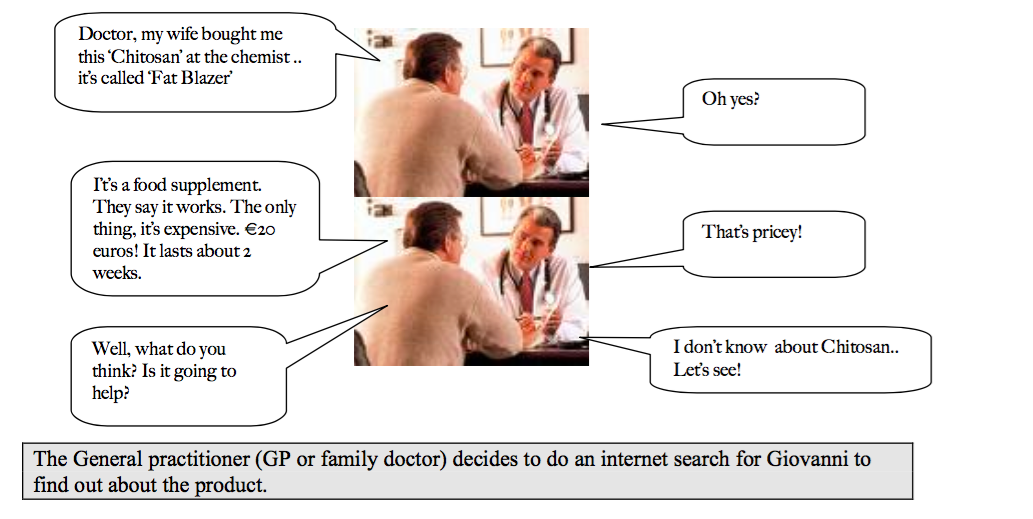
-
Instructions
I want you to imagine you are patient searching for info on the web. You are probably pretty good already! Try to look, however, for the potential traps patients might fall into using the internet. Might these cause problems to doctors? Use the forum to share your thoughts!
Do your own search and see what you find
a) Google or Yahoo
b) What kind of information did you find?
c) How would you rate the quality of the information?
d) Is it enough to answer Giovanni’s question?
e) How many and what kind of hits did you get? Was it scientific? Commercial? Trustworthy?
Keep a record of your results in your portfolio -
Read the lesson notes for activities 1.7- 1.9 After doing your own searches examine your Medline results. Does 'chitosan' work. Read the abstracts carefully and weigh the evidence. Then answer the questions in this quiz.
-
Write a short synthesis of the evidence based medicine (EBM) themes of this module (max 200 words). Write in English or Italian. You can refer to Giovanni's case. In your summary, connect the key concepts in the shapes on page 8 of your lesson notes: quality care; EBM; Medline & internet technology; patient issues; English language.
Before starting, remember to refer to the GIMBE website link in the introduction to clarify what we mean by 'evidence' in medicine. This as an individual exercise.
Provide at least two reference from your Medline searches below your answer. Write the reference professionally for a medical publication (hint: look at the lesson notes for a study box example, or the reference list of a clinical paper for a model)
-
-
This lesson will develop your skills to use the largest medical source of evidence in the world: Medline. Watch the videos on how to use the medical search engine PUBMED and then do the practice exercises. Remember to register as a MEDLINE user so that you can login and save your searches for future reference. These skills are essential for all doctors and I hope you will start using the resource to do your own searches on subjects you are studying to find the latest evidence.
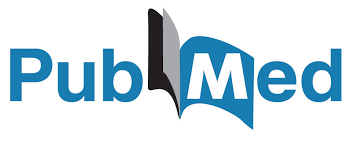

-
Instruction
Watch the 6 short tutorials to become competent using PubMed. You can look at the videos as many times as you like. When you finish do the short exercises to practice your new skills. You can follow the online instructions or also download the exercises as a PDF on the link "Search Exercises"
-
Instructions
The following exercises will give you practice using PubMed. Exercise 1 is an example. Follow the steps and then try yourself. A pdf version of the online instructions and exercises is also available in the link)
To begin:
1. Register on PubMed and sign in as a user with 'My NCBI'
2. Do each of the search exercises below on your computer and save each search on 'My NCBI'
Exercise 1 - A worked example
StrategySpecific Question.
A mother and father come to your surgery with their 6-year-old son, John, who is suffering from hay fever symptoms. The symptoms started 2 weeks ago. They have tried antihistamines, but John fell asleep at school. John’s father asks:Are there medications that John can take that won’t make him sleepy? John’s mother takes an anti histamine called Claritin (Loratadine) for her hay fever. Is that safe for children?
STEP 1. What key words describe the problem?
P Allergy, allergic rhinitis, hay fever, hypersensitivity
I Claritin OR Loratadine
C Alternative antihistamines
O Reduce symptoms, safety, efficacy,
STEP 2. What is the clinical question?In a 6 year old child is Claritin compared to alternative therapies more effective to reduce the symptoms of hay-fever?
STEP 3. What combinations of words will be most effective on Medline?
You need to experiment with different combinations and compare results
Combination 1:
(hay fever OR allergic rhinitis) AND (Claritin OR Loratadine) AND (alternative antihistamines) AND (safety OR reduction of symptoms)
Limits: Randomized Controlled Trial, Journal Article, English, All Child: 0-18 years, published in the last 5 years
Combination 2
Search 2: (hay fever) AND (Claritin OR Loratadine) AND (safety OR reduction of symptoms)
Limits: Randomized Controlled Trial, Journal Article, English, All Child: 0-18 years, published in the last 5 years
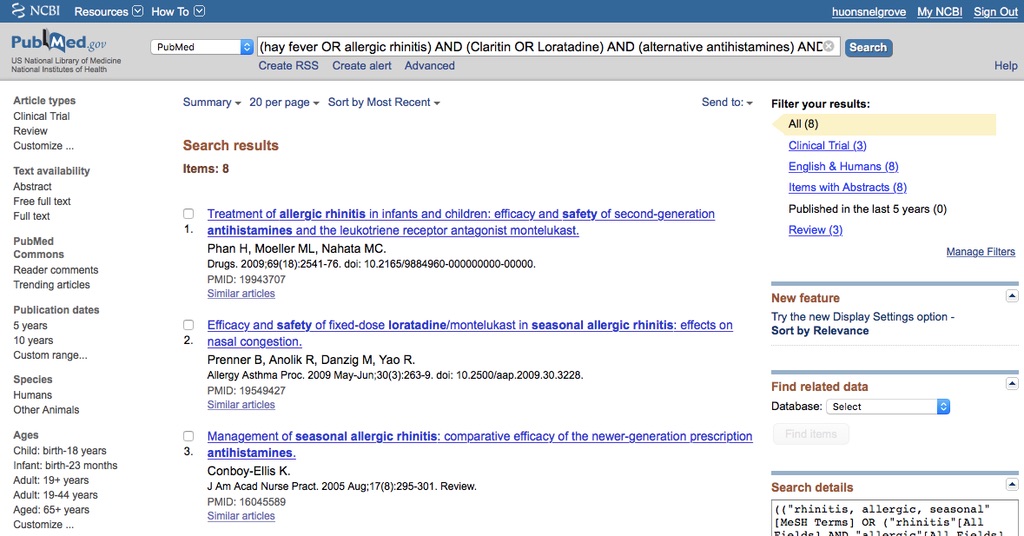
SEARCH STRATEGY STUDY COMMENTS
I used a few, but not all my combinations. After examining the abstracts I might decide to continue with more searches using other combinationsNotice that I used the Limits function to indicate ‘child’ and included MeSH and free text works.’
Because I was interested in studies whch asked ‘What treatment is best?’ I included a generic alternative in the comparison field (“alternative antihistamines’). However, this is not always necessary.
When I wrote “allergy” in the MeSH window I saw that “allergy” was not a MesH term. The MeSH browser indicated a synonym “ hypersensitivity”. With this word I scrolled down the MeSH page, or hierarchy of terms.
Under the term ‘hypersensitivity’ I found Hey fever/ Rhinitis, Allergy,Perennial. You can add these terms to you main search window.
Exercise 2 - You try
Specific Question.
A mother of a young African girl with cerebral malaria has told you she knows of a drug called ELQ-300 which may save her daughters life or at least reduce risks significantly.Strategy
STEP 1: What key words describe the problem?
(Hint: Refer to your microbiology text for clinical information about cerebral malaria and use the MeSH function on PubMed to identify other key concepts)
You want to know if there is any evidence of a new drug that reduces risks of complications and/or death compared to current therapy.
‘Patient’ - What kind of patient? What is the condition?
Intervention’ - What do we want to do to help the patient?
Comparison - What alternatives of treatment exist?
Outcome’ - What do we want to happen after the intervention?
Create a table to generate your key words.
STEP 2: What is the clinical question?
STEP 3: Conduct your searches using different combinations of key words from your table
STEP 4: Share your KEY WORDS and successful search strategies on the Forum with other students
-
It's easy to find information on the internet. Anybody can access medical information online. And your patients do. You need to develop an excellent understanding of how to use the medical systems. I hope the practice exercises and videos in this module will help you. Use this forum to exchange ideas or suggestions with your peers.
-
Here are 10 simple questions to test what you have learned about the different functions of the PubMed search engine which we use to find evidence on the Medline database
-
Instructions
Recognizing and writing structured clinical questions is key to success in the final exam. Study these exercises carefully.
1) Read the brief clinical scenario for each question
(2) Try to identify the components of P.I.C.O.
(3) Match the letters in PICO
(P=Population/problem; I = Intervention, Index or Indicator; C= Comparator or
Control; O = outcome
with the best possible answers. -
Now that you have developed your skills, you can conduct a more detailed search for evidence. You can choose
-
a) To go think back to the Jennifer’s story of her gastric bypass on YouTube (Lesson 1.1). What is the medical evidence for the effectiveness? Were there any effective alternatives?
-
b) To choose another clinical topic which is related to your study (or personal interests). Or which interest you particularly. Whatever subject you choose, this is an individual task.
Save your searches on PubMed's 'MY NCBI'
-
-
-
Instructions
Read the case description of a patient suffering from a cold. Do the exercises to develop a Medline strategy to search for evidence-based answers to your clinical question. Finally, write your synthesis in English or Italian following the guidelines.

Patient Case Description
You meet a family friend who has a bad cold. She is a 26 year-old female. She tells you her symptoms are cough and very blocked noses making it difficult to breathe through her nostrils and sleep at night. Her partner says she snored all night.She feels completely congested and is taking paracetamol. In the pharmacy this morning she saw two anticongestants made by the same company under the brand 'Otrivine'. One is a saline solution and the second contains 'xylometazoline'. The pharmacist suggested you buy one. 'Which one should I choose?" she asks you. You decide to do a Medline search.

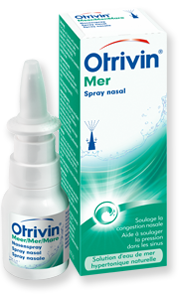
Steps for your Search Strategy:
1. Identify the problem and write a clinical question
2. Identify at least 8 key words that describe the problem using PICO
3. Conduct at least 3 different searches on Medline with different combinations of your key words (Save your searches to My NCBI on PubMed)
4. Find at least 3 relevant papers published in the last 10 years (2006-2016) (including one 'review')

Online Synthesis of Results
Write a short 250 word synthesis in English or Italian of the 3 articles you found about nasal decongestants
(a) State the problem and your clinical query (1-2 sentences)
(b) Describe your search strategy, the key words you used, filters you applied, and number of results. (1-2 sentences)
(c) State what papers you selected. " e.g. I included 2 RCTs by Smith (2010) and Ellis 20113) and one Review (2014)
(d) Synthesise the evidence in your own words (3-4 sentences)
(e) Conclusion: Answer your clinical question
(f) Reference the papers professionally (minimum 3 papers) Copy and paste from your Mendele library. Your references are not included in 250 word count.
(g) Keep a back up copy on Word.
-
Write your 250 word synthesis of evidence you found on Medline. Keep a back up copy for your own records
-
Instructions
1. Read the paper entitled:
"The nasal decongestant effect of xylometazoline in the common cold" and answer the questions carefully.
2. Try to answer the questions quickly (if possible without looking at the paper!
)
Time: You have 15 minutes to finish the test.
-
-
Accurate citations of the evidence in medicine is very important. In the short exercises in this course you are asked to cite papers you have found on Medline. These need to be formatted accurately. Download the software MENDELEY from the link below and make it easy. This section also introduced you to the digital library at La Sapienza. From Medline you can go to SBS and get many full text articles you want to read. These skills are really important for you as a future doctor. Take your time and become skilled at using these resources.
Instructions for this section
1. Choose a bibliographic software and download it onto your computer (its free)
2. Experiment with the software by using ut to search Medline and to import citations (try importing and exporting citations onto a Word document)
3. Learn to use your university digital library SBS, and search for journals and papers you have used on this course
5. Learn to use ACNP and try to locate a library in the hospital with a paper you have read on this course
6. Register with BIXY so you can use the digital library from your home.
-
In medical communication it is always important to cite your sources. In your summaries for Karen's case you should cite the evidence you found on your PubMed search and use it to reach your conclusion about Karen’s case.
In medicine the format for bibliographic citations is the following: Author/Year/Title of article/ Name of Journal/ Volume/Issue/ pages
For example:
Chan S, Brown S, Davis T, et al Acute bacterial gastroenteritis: a study of adult patients with positive stool cultures treated in the emergency department Emergency Medicine Journal (2003) 20; 335-338For your final exam and for your thesis you need to download a bibliographic software. See the link below and start now!
 Per aprire la risorsa fai click sul link http://www.mendeley.comFor examples and guidelines from the International Biomedical Journal Committee on how to cite papers, books, www sites and other material visit:http://www.nlm.nih.gov/bsd/uniform_requirements.html
Per aprire la risorsa fai click sul link http://www.mendeley.comFor examples and guidelines from the International Biomedical Journal Committee on how to cite papers, books, www sites and other material visit:http://www.nlm.nih.gov/bsd/uniform_requirements.html -
The University of Rome has a large digital library. You can find full text articles of papers in the medical section. When you find a paper on Medline you want, you go to SBS and log on. You can also di this from your home using Bixy ( a proxy server)
Instructions
Register online and download BIXY following the instructions.
-
If Sapienza University of Rome does not have an electronic version of the journal you need in its digital library you can locate a paper copy anywhere in Italy using the ACNP search engine.
Instructions
1. For 'Title' write the name of the Journal: (e.g. 'BMJ' or 'British Medical Journal" or Brit* Med* J*)
2. Indicate 'Roma' and Lazio
The search engine will tell you where to find a paper copy in the hospital.
-
